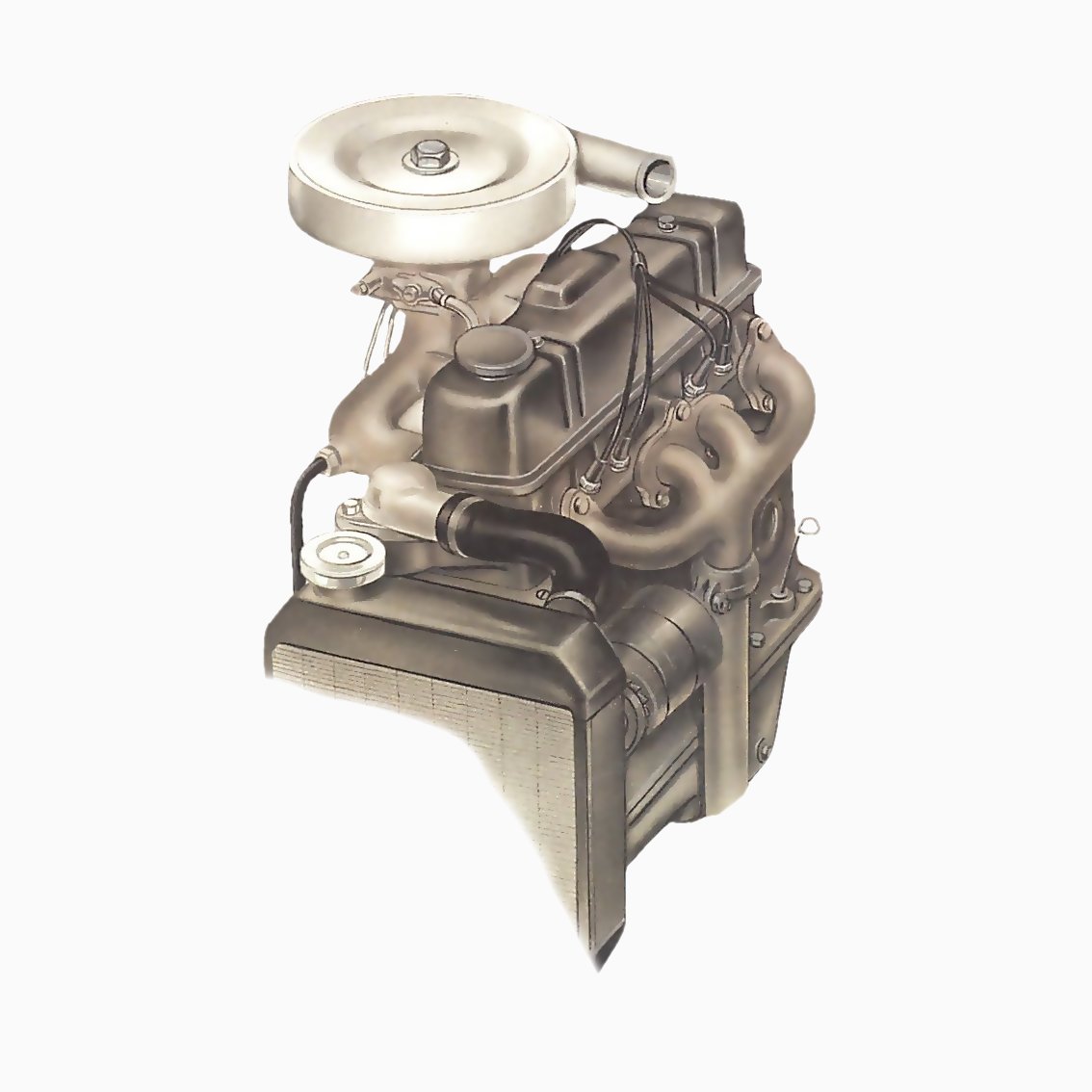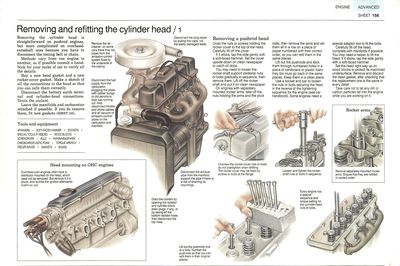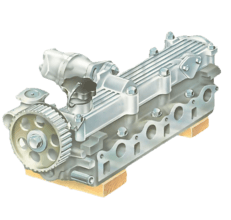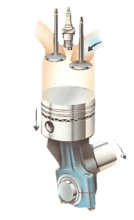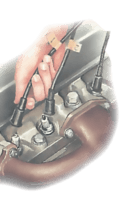
Vous pourriez avoir besoin de
Removing the cylinder head is straightforward on pushrod engines, but more complicated on overhead-camshaft ones because you have to disconnect the timing belt or chain.
Methods vary from one engine to another, so if possible consult a handbook for your make of car to verify all the details.
Buy a new head gasket and a new rocker-cover gasket. Make a sketch of all the connections to the head so that you can refit them correctly.
This video course is the best way to learn everything about cars.
Three hours of instruction available right now, and many more hours in production.
- 4K HD with full subtitles
- Complete disassembly of a sports car
Disconnect the battery earth terminal and cylinder-head connections. Drain the coolant.
Leave the manifolds and carburettor attached if possible. If you do remove them, fit new gaskets (See Exhaust manifold gasket replacement).
Removing a pushrod head
Unscrew the rocker-cover nuts or bolts; do not over tighten when refitting. The rocker cover may be fixed by nuts or bolts at the flange.
Undo the nuts or screws holding the rocker cover to the top of the head. Carefully lift off the cover.
If it sticks, tap the side gently with a soft-faced hammer. Set the cover upside-down on clean newspaper to catch oil drips.
You may need to loosen the rocker-shaft support pedestal nuts or bolts gradually in sequence, then remove them. Lift off the rocker shaft and put it on clean newspaper.
Lift out the pushrods one at a time. Number the pushrods so that you can refit them in their original places.
On engines with separately mounted rocker arms, take off the nuts holding the arms and the pivot balls, then remove the arms and set them all in a row on a piece of paper numbered with their correct order, so you can refit them in the same places.
Lift out the pushrods and stick them through numbered holes in a piece of cardboard or plastic foam; they too must go back in the same places. Keep them in a clean place.
Loosen and tighten the rocker shaft nuts or bolts in sequence.
Use a socket and bar to loosen the nuts or bolts securing the head in the reverse of the tightening sequence for the engine (see car handbook). Some engines need a special adaptor tool to fit the bolts.
Carefully lift off the head, complete with manifolds if possible. You may need a helper to lift the head. If it sticks, tap the side gently with a soft-faced hammer.
Every engine has a special sequence and torque setting for the head nuts or bolts.
Set the head right way up on wood blocks to protect its machined undersurface. Remove and discard the head gasket, after checking that the replacement one is the same in every detail.
Take care not to let any dirt or carbon particles fall into the engine while you are working on it.
Rocker arms
Remove separately mounted rocker arms. Ensure that they are refitted in the correct order.
Removing an overhead-cam head
Unbolt the cover of a timing belt and take it off, or move it aside.
If the engine has a timing belt, remove the screws or bolts holding the belt cover to the front of the engine and pull the cover clear. Take care not to get oil on the belt.
Slacken the locking device of the belt tensioner (See Adjusting a camshaft timing belt).
Loosen the belt tensioner to free the belt from the camshaft sprocket.
Push the tensioner wheel out until you can free the belt. Take the belt off the camshaft sprocket, taking care not to rotate either the camshaft or crankshaft.
Unbolt and remove the camshaft cover.
Undo the nuts or screws holding the camshaft cover to the head. Carefully lift off the cover: if it sticks, tap gently on each side with a soft-faced hammer. Set it upside-down on clean newspaper to catch oil drips. Remove and discard the gasket.
If the engine has a timing chain, after removing the camshaft cover, remove the nut from the camshaft sprocket. Pull off the sprocket and support the chain. Be careful not to drop any part into the chain case.
Every engine has a special sequence and torque setting for the head nuts or bolts.
To remove the cylinder head, use a socket and bar to loosen securing nuts or bolts in the reverse order of the special tightening sequence for the engine. Some engines need a special tool to fit the bolts.
A gentle sideways tap with a soft-faced hammer will release a sticking head.
Carefully lift off the head - you may need a helper. If it sticks, tap the side gently with a soft-faced hammer. Set the head right way up on wood blocks to protect its machined undersurface. Remove and discard the head gasket, taking care not to let any dirt or carbon fall into the engine.
Refitting the cylinder head
Refitting is mainly a reversal of the removal procedure, but there are certain extra steps for both pushrod and overhead-cam engines (see below).
Check that the head and block faces are absolutely flat, using a steel rule (See ). See, too, that they are clean. Lay the new gasket on the block, right way round: the upper side is marked 'top', 'haut' or 'oben'.
Lower the head into place, taking care not to displace the gasket. Refit the head nuts or bolts and tighten in the correct sequence to the required torque setting.
Refit all other parts, except for the rocker or camshaft cover and the air cleaner, in the reverse order of dismantling.
Check the valve clearances at the 'cold' setting (See Checking and adjusting valves). Refit the rocker or cam cover, using a new gasket.
Refill the cooling system and start the engine. Check for coolant leaks (See Checking and topping up car antifreeze coolant).
When the engine is at its normal working temperature, switch it off and check the valve clearances at their 'hot' setting if specified (see the car handbook).
Pushrod engine
Make sure all the pushrods are engaged with their rockers before you tighten any nuts or bolts.
After tightening the head bolts, refit the pushrods in their original places, followed by the rocker shaft or separate rockers.
In either type, be sure that the upper end of each pushrod is engaged with its rocker and that the lower end is seated in the tappet before tightening the nuts or bolts.
Tighten rocker-shaft nuts or bolts in the recommended sequence and to the recommended torque - consult the car service manual or a dealer.
Overhead-cam engine
Before refitting the head to an OHC engine, set No.1 cylinder to TDC and line up the corresponding marks on the camshaft drive belt sprocket. A chain-drive sprocket has similar marks.
Before installing the cylinder head, turn the crankshaft with a spanner on the pulley nut until No. 1 piston is at its top-dead-centre (TDC) position of its compression stroke.
Verify this from the TDC mark on the crankshaft pulley. Turn the camshaft until the mark on its sprocket is in the correct position for No. 1 cylinder firing. Now refit the head and tighten its bolts.
Before refitting the head to an OHC engine, set No.1 cylinder to TDC and line up the corresponding marks on the camshaft drive belt sprocket. A chain-drive sprocket has similar marks.
Check that the crankshaft and camshaft are still at their marks, then refit the drive belt or chain.
Slowly turn the crankshaft two full turns in the normal direction of engine rotation.
Make sure the timing marks are again in alignment then, for a belt-driven camshaft only, adjust the tensioner (See Adjusting a camshaft timing belt).
If the marks do not line up, reposition the crankshaft first, then the camshaft.

